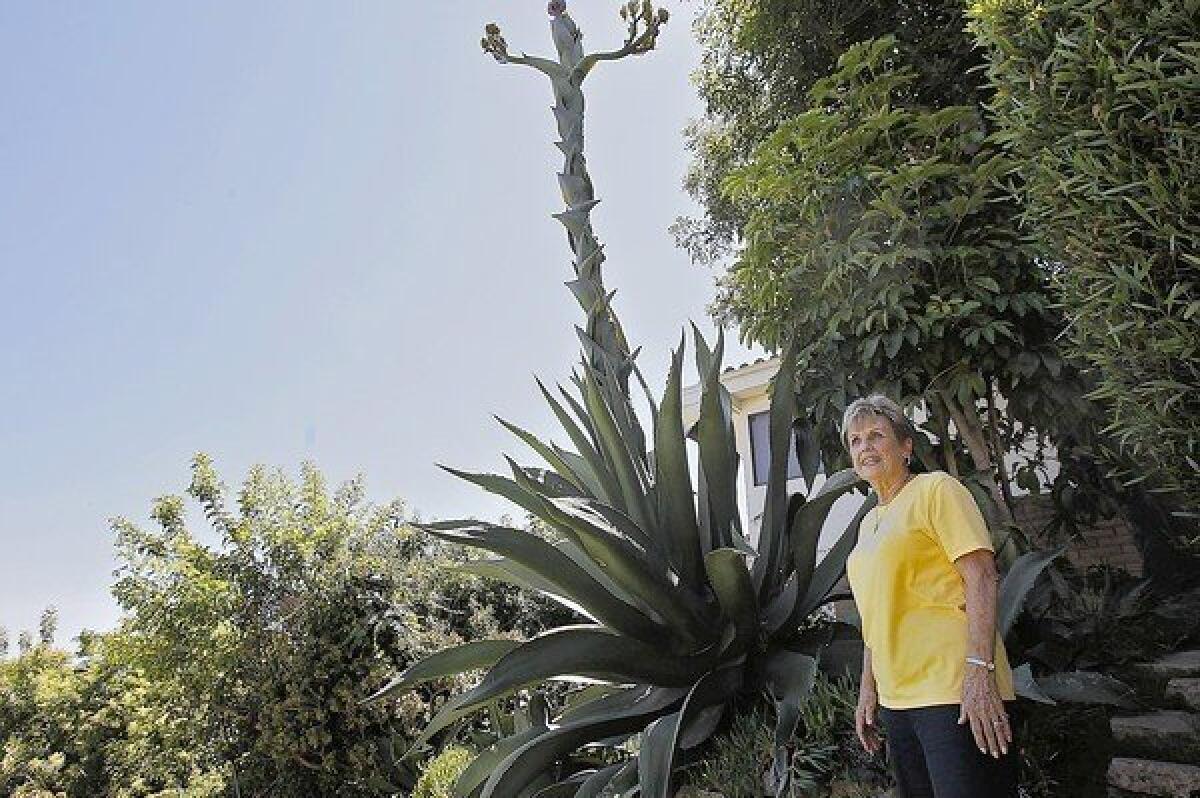Giant agave plant, tall as a 2-story house, stands out in backyard

There’s a monster in Nancy and Jack Geerlings’ backyard in Newport Beach — and it’s been growing.
“Our neighbors keep coming in and saying, ‘Oh my gosh,’ ” Nancy Geerlings said, shading her eyes to look up at the monster’s head, which, for the first time in nearly three decades, has begun to sprout clusters of dusky pink and chartreuse blossoms.
Some might find the thing intimidating. The specimen is, after all, about the height of a two-story house. It’s broad as a bus at its base and its gray-green appendages, which point in all directions, end in sharp points, like a bouquet of Hagrid-sized daggers.
The Geerlings, who were profiled in the Daily Pilot, see their resident giant, commonly known as a century plant, as a more benevolent presence.
“You’ll notice that it welcomes you with open arms,” Jack Geerlings said.
But now, after spending the past 25 years slowly stretching toward the sun, the towering plant — with the scientific name Agave americana — that looks out over Newport Harbor from a perch behind the Geerlingses’ home in the Westcliff neighborhood, is getting ready to die.
Agaves, many of which are native to Mexico and the Southwest, typically grow slowly, storing up energy, said Stephen Weller, a professor of ecology and evolutionary biology at UC Irvine. Once they do, though, most die rather than branch off at their base.
“Evolutionarily that’s pretty interesting,” he said. “I think the idea is that by producing this very large inflorescence and waiting until enough energy has been produced, then it produces so many seeds that the probability of some of them establishing becomes quite high.”
While Agave americana can take anywhere from about 15 to 25 years to grow large enough to flower, upon seeing a picture of the Geerlingses’ specimen, Weller said, “It’s one of the bigger ones.”
Nancy said she and Jack have never really done anything to encourage the plant’s growth.
“I don’t know much about it,” she said with a shrug.
Weller said they’re fairly common in the area.
Still, he wrote in an email, “this is a monster plant, and very impressive.”
The Geerlingses’ plant is a descendant of an Agave americana that was already in the yard when the family first moved in, back in the early 1970s. Then, about 15 years later, it bloomed.
A couple months after it first started to flower, the asparagus-like stalk fell over, Nancy recalled.
“I was at school, so I didn’t see it,” she said. Nancy, who along with Jack, is now retired, taught English at Corona del Mar High School.
But someone, a passerby on Pacific Coast Highway below the house, noticed the fallen succulent. He stopped by and asked if he could take it.
“I said, sure, but what do you want that for?” Jack said. “He said, ‘You don’t know?’”
Liquor, the man said. Not tequila — because, just as Champagne must come from France, tequila must come from Mexico — but a kind of agave-based moonshine.
So, Jack said, the man hauled off the dead plant “in maybe six-foot strips.”
Asked if they had similar plans for the plant blooming now, Nancy shook her head and laughed. “We don’t do that,” she said.
That may be for the best, said Greg Starr, who owns a Tucson, Ariz., nursery that specializes in agave and cactus. Starr also recently published a book on agaves.
In Jalisco, Mexico, where real tequila originates, rich volcanic soil makes for thriving crops of particular types of agave that distill into the best liquor.
Plus, Starr said, “down in Mexico, they have these grinding wheels that are dragged around in circles by donkeys or burros that mash up the cabeza, or the head. It’s a long process.”
Instead, he said, the Geerlingses might try hollowing out the long stalk and making an instrument similar to the Australian didgeridoo.
“I’ve seen people play these,” Starr said. “They’ll cut [the stalk] down to maybe a 10- or 12-foot section.”
Whether or not Jack and Nancy decide to try their hands at honing a didgeridoo from their fallen monster, Jack said he enjoys having the plant around.
“It’s positive.”
ALSO:
L.A. Unified unveils plan to bring arts into academics
San Diego Democratic Party won’t yet call for Filner’s resignation
At least 6 arrested at Zimmerman trial protest in San Bernardino
Cowan writes for Times Community News.
More to Read
Sign up for Essential California
The most important California stories and recommendations in your inbox every morning.
You may occasionally receive promotional content from the Los Angeles Times.










